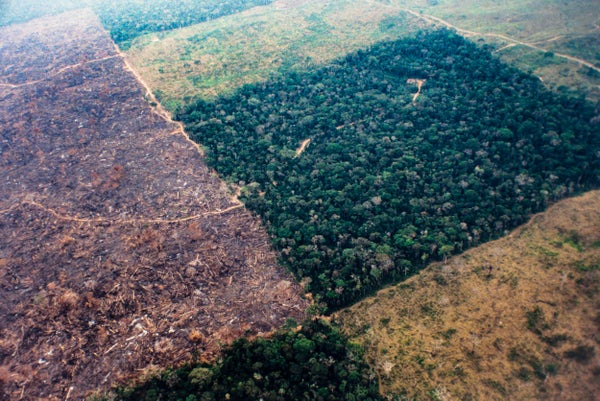About one in eight of all the world’s trees grows in the Amazon, by far the largest remaining continuous rain forest on earth. The greatest threat to its existence has long been deforestation: by 2013 it had lost an estimated 11 percent of its original extent to land clearing. By 2050, the business-as-usual scenario used in a recent study suggests, that number might reach a devastating 40 percent.
Now another threat looms: the impact of climate change on many tree species’ abilility to survive. In a study published Monday in Nature Climate Change, researchers in Brazil and the Netherlands present an analysis combining a number of scenarios for climate change and deforestation. They predict that by 2050 the average number of tree species found in any one part of the Amazon rain forest could decline by up to 58 percent, and that roughly one in three of the more than 6,000 species in the study could become critically endangered or go extinct.
First, the scientists created maps showing where each species is likely to occur today, explains lead author Vitor Gomes of the Federal University of Pará in Brazil. Layering those maps atop one another allowed Gomes and his colleagues to calculate how many species are present, on average, within areas of 10 by 10 kilometers. At this moment, they determined, any given area probably has on average almost 1,500 of the 6,394 tree species for which sufficient data were available.
On supporting science journalism
If you're enjoying this article, consider supporting our award-winning journalism by subscribing. By purchasing a subscription you are helping to ensure the future of impactful stories about the discoveries and ideas shaping our world today.
Knowing the specific areas where these trees are currently found gave the researchers an idea of the temperature and rainfall patterns each species is apparently comfortable with. They then created new maps predicting where the species’ current ranges would likely still have such conditions in 2050. Layering these new maps indicated climate change might result in a decline of 31 to 37 percent in the average number of species found in any one area.
Adding business-as-usual deforestation rates to the model, the researchers predicted the loss of at least another 20 percent, which would lead to a 58 percent average decline in species numbers in any given fragment by 2050. “Unfortunately,” says co-author Hans ter Steege of the Naturalis Biodiversity Center in the Netherlands, “this scenario appears increasingly realistic, as deforestation in the Amazon is rising again, and current efforts to limit global warming are clearly insufficient.”
This is bad news, because the study also produced a map predicting the state of the Amazon if business as usual indeed continues for both the climate and deforestation until 2050. It shows the Amazon rain forest may be effectively cut in two by then. The northwestern half, which is farther away from the current deforestation front, remains more or less continuous in this projection—but the southeastern half is so severely fragmented that hardly any continous forest remains. This projection means even tree species that are now very common in the southeast—such as Protium altissimum, which produces a valuable aromatic resin and fruits that are relished by monkeys—may be in danger.
Yet even in northern and central areas, where there is much less deforestation, the study suggests climate change will pose risks for species such as the drought-sensitive Eperua falcata, or bootlace tree. This tree produces large seed pods that appear to hang from its branches by bootlaces and burst open with a bang in the dry season to spread seeds to new areas. But even this explosive strategy is unlikely to help the species outrun climate change. “The seeds spread only about 15 meters from the tree crown, and it will take the trees that grow from them about a century to reach maturity,” ter Steege says. “Many tree populations similarly move very slowly. I often read papers claiming that due to climate change, certain forest types will be found in a different region in 2050. But how can they ever get there? Will the trees take a train?”
Large birds and mammals may help spread certain seeds, he notes. “But in highly fragmented areas these animals are often the first to go, because they need larger territories or because they are hunted. So the trees that depend on them eventually disappear.” Fragmented areas of forest are also more vulnerable to climate change, ter Steege adds, because more trees are near the edge and therefore more likely to be affected by drought or fire.
Thus, even though protected areas may not entirely shelter tree species from climate change, the larger stretches of forest they safeguard probably do enhance their chances of survival. “In our model, forests outside the protected areas lost up to a third more species from climate change and deforestation,” Gomes says.
Tropical biologist Kenneth Feeley of the University of Miami, who was not involved in the study, agrees that well-connected protected areas will be increasingly important.
He suspects that additional impacts of fragmentation, not modeled in the new study, might make tree species disappear even faster than predicted. Carlos Nobre, an earth system scientist at the University of São Paulo in Brazil, who was also not involved in the new study, adds that many species are interdependent—so the disappearance of one might decrease the suitable area for another. At the same time, Feeley adds, there are very few data that indicate whether some trees might adjust to higher temperatures or increased drought. Clearly, more research is needed to find out what really makes trees disappear.
